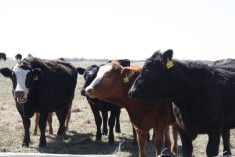Fed cattle down
The cattle complex remains in limbo with uncertain demand and ample supply.
A few cash cattle traded with the steer weighted average at $158.57 per hundredweight, down $1.33, and heifers at $157.17.
Dressed sales were $260-$266.50 per cwt. delivered, with varied packer interest and negotiated delivery dates.
Fed cattle and most of the feeders at auction were down about $20 per cwt., compared with the same week last year.
Few fed cattle traded south.
Cattle futures fell, tightening the Alberta cash-to-futures basis to -$12.56. U.S. cash prices were generally US$2 -$3 lower.
Read Also

Defence investments could benefit agriculture
A bump in Canada’s NATO spending commitments could lead to infrastructure investments that would benefit rural areas
Live sales in the southern United States were mostly at $124, and dressed trade in the north started steady at $195 and eased to $190-$192 by the end of the week.
Weekly western Canadian slaughter to Nov. 28 rose three percent to 30,119 head.
Slaughter in recent weeks has topped the five year average for this time of year. Weekly exports to Nov. 21 rose to 5,331 head.
Weekly slaughter is consistent, even with reduced beef demand.
Statistics Canada’s Oct. 1 cold storage report said beef stocks were 14 percent higher than last year. The Jan. 1 report will likely indicate even larger stocks.
The tight cattle supplies of 2014 are now a thing of the past, and the cattle complex is struggling to establish a new lower but still historically strong price point.
Modestly tighter market-ready supplies in the first quarter of 2016 should support prices.
Cows lower
D1, D2 cows ranged C$94-$113 to average $101.25, and D3 cows ranged $80-$100 to average $89.42.
Rail grade cows were $198-$203.
Western Canadian cow slaughter was 8,500 head, the second largest this year.
Non-fed supplies increased as they normally do this time of year, but volumes are manageable.
Many cows are still grazing thanks to the mild weather, reducing the demand for winter feed stocks.
Producers appear willing to carry some of their culls into the new year, hoping for a price rebound.
Ninety percent lean hamburger prices in the U.S. tend to rally toward the end of the year, but large stocks of boneless beef in cold storage will cap prices.
Feeders down
Feeder prices fell with extra pressure toward the end of the week as deferred live cattle futures fell to contract lows.
Prices by the end of the week looked $5-$10 weaker.
Some cattle set for sale in electronic sales were pulled. Also, some producers postponed or delayed hauling cattle to town, hoping for futures markets to rebound.
Feeders 550 and 750 lb. traded at the lowest levels since late summer 2014.
Alberta 550 and 750 lb. steers are still trading at a slight premium to the U.S. market.
Calf and feeder prices will continue under pressure because the historically strong Canadian cash -to-U.S.-cash basis will be tough to sustain.
A few preconditioned calves were offered, but they are not fetching a premium over freshly weaned calves.
As well, the market is not paying a premium for forward-contracted cattle for spring delivery.
Bred market prices are holding up with average bred cow and heifer prices comparable with last year.
Bred cows were $1,800-$3,150 per head, bred heifers were $2,000-$3,450 and cow-calf pairs were $2,300-$2,800.
Buyers appear to be paying for quality cattle. Demand for dispersal cows and one-owner heifers have been particularly strong.
Most bred cattle on offer are re-entering herds, but older cows or bottom end bred heifers are going for slaughter-feeder prices.
U.S. beef steady
Choice cutout last week was US $204.49, up 40 cents, and Select was $193.02, down 74 cents.
Weekly Canadian boxed beef to Nov. 28 saw AAA down C$4.69 at $263.98 and AA down $6.42 at $252.82.
The cutout has been running below year ago levels since mid-November and is now $23-$24 per cwt. lower.
Fed cattle prices are now nine percent lower than December 2014, and beef demand is soft.














